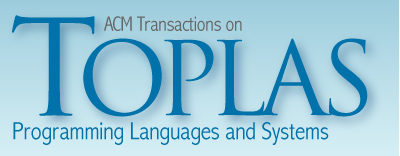Acceptance Criteria
Papers for TOPLAS must be of high quality and fall within the scope of the journal. The scope of the journal includes, but is not limited to:
- language design for sequential and parallel programming
- programming language implementation
- programming language semantics
- compilers and interpreters
- runtime systems for program execution
- storage allocation and garbage collection
- languages and methods for writing program specifications
- languages and methods for secure and reliable programs
- testing and verification of programs
Papers can be either theoretical or experimental in style, but in either case, they must contain innovative and novel content that advances the state of the art of programming languages and systems. We also invite strictly experimental papers that compare existing approaches, tutorial, and survey papers.
The three main criteria for a paper to be accepted are:
- the paper must be among the best papers of the year in its area
- the paper must be of interest to the broad community
- the presentation must be effective.
Few papers excel in all three, but a substandard level in any is sufficient grounds for rejection. It is the authors' job to make it clear why the paper is important and of broad interest. We ask authors to consult a recent issue of TOPLAS for reference.
To ensure that authors feel comfortable submitting despite these
high standards, we aim for a two-step review process. In the first
step, referees are asked to scan the paper to decide if it meets these
criteria, assuming that all the results are correct as stated. If
it seems that the paper might satisfy these criteria, either the same
or different referees are then asked to provide a more in-depth review.
If a paper is rejected from TOPLAS but makes an interesting contribution, we offer authors the
option of having the reviews forwarded to the editor-in-chief of a more
appropriate journal for an expedited review process.


